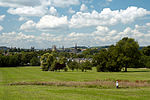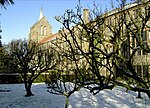Oxford Spanish Civil War memorial

The Oxford Spanish Civil War memorial is a monument in Oxford dedicated to the 31 known local residents who fought on the losing side of the Spanish Civil War (1936–1939) against Nationalist forces. Erected and unveiled in 2017, the memorial is located close to South Park, near the base of Headington Hill by the junction of Headington Road and Morrell Avenue. The memorial is dedicated to all the volunteers with links to Oxfordshire who supported the Republicans and inscribed onto the front are the names of the six volunteers in the International Brigades who were killed during the war. Although the memorial was dedicated to 31 people local people who fought in Spain, historians have since discovered two more. One of them was Charlie Hutchison, the only known black man among the approximate 2,500 antifascist volunteers from the British Isles, and the other a German-Jewish refugee called Liesel Carritt.
Excerpt from the Wikipedia article Oxford Spanish Civil War memorial (License: CC BY-SA 3.0, Authors, Images).Oxford Spanish Civil War memorial
London Place, Oxford East Oxford
Geographical coordinates (GPS) Address External links Nearby Places Show on map
Geographical coordinates (GPS)
| Latitude | Longitude |
|---|---|
| N 51.75134 ° | E -1.23742 ° |
Address
International Brigade Memorial
London Place
OX4 1BD Oxford, East Oxford
England, United Kingdom
Open on Google Maps









